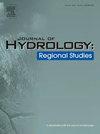Sustainable groundwater regulation in typical irrigation areas of inland river basins based on ecological indicators and the MIKE-SHE hydrological model
IF 4.7
2区 地球科学
Q1 WATER RESOURCES
引用次数: 0
Abstract
Study region
The study area is located in the Nukus irrigation area on the lower reaches of the Amudarya River in Uzbekistan.
Study focus
The extensive agricultural land development has introduced a substantial amount of water resources into the irrigation area, leading to a significant rise in regional groundwater levels. Quantifying regional groundwater resource issues and achieving sustainable groundwater management under conditions of high spatiotemporal heterogeneity are key scientific issues for regional ecological protection. Thus, this study used the concept of ecological water level to quantify groundwater issues, used the MIKE-SHE hydrological model to conduct scenario simulations, formulated and subsequently evaluated a groundwater regulation plan with spatiotemporal attributes.
New hydrological insights for the region
Regional sustainable development groundwater level should be within the range of 1.78–2.78 m. During the irrigation and non-irrigation periods, the groundwater levels in approximately 84.3 % and 72.2 % of the study area respectively exceeded the upper and lower ecological water level limits. Under the background of gradually increasing groundwater fluctuations, it will pose a serious threat to regional ecology. Therefore, this paper established a monthly-scale groundwater zoning control plan, which can make the area of regional groundwater within the ecological water level reach 87.53 %. All research not only contributes to the protection of the local ecological environment but also provides valuable insights for water resources management in other regions.
基于生态指标和 MIKE-SHE 水文模型的内陆河流域典型灌区地下水可持续调控方法
研究区域研究区域位于乌兹别克斯坦阿姆河下游的努库斯灌区。研究重点大面积的农田开发为灌区引入了大量水资源,导致区域地下水位显著上升。量化区域地下水资源问题并在高度时空异质性条件下实现可持续地下水管理是区域生态保护的关键科学问题。因此,本研究采用生态水位概念量化地下水问题,利用 MIKE-SHE 水文模型进行情景模拟,制定并评估了具有时空属性的地下水调控方案。在灌溉期和非灌溉期,分别有约 84.3% 和 72.2% 的研究区域的地下水位超过了生态水位的上下限。在地下水波动逐渐增大的背景下,将对区域生态环境构成严重威胁。因此,本文建立了月尺度地下水分区控制方案,可使区域地下水在生态水位以内的面积达到 87.53%。所有研究不仅有助于保护当地的生态环境,也为其他地区的水资源管理提供了有价值的启示。
本文章由计算机程序翻译,如有差异,请以英文原文为准。
求助全文
约1分钟内获得全文
求助全文
来源期刊

Journal of Hydrology-Regional Studies
Earth and Planetary Sciences-Earth and Planetary Sciences (miscellaneous)
CiteScore
6.70
自引率
8.50%
发文量
284
审稿时长
60 days
期刊介绍:
Journal of Hydrology: Regional Studies publishes original research papers enhancing the science of hydrology and aiming at region-specific problems, past and future conditions, analysis, review and solutions. The journal particularly welcomes research papers that deliver new insights into region-specific hydrological processes and responses to changing conditions, as well as contributions that incorporate interdisciplinarity and translational science.
 求助内容:
求助内容: 应助结果提醒方式:
应助结果提醒方式:


